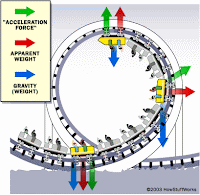 |
| No, I'm discussing a different "Big Three" |
Most high schools teach two or three different levels of introductory physics. There's the conceptual course, often offered at the ninth grade level; the "college prep" or "Regents" level; and then there's the AP, IB, or collegiate level. In broad terms, the primary difference among the levels is twofold: the depth of mathematics used, and the pace of the course.*
* People are often surprised to find that the algebra-based AP physics course uses no more mathematics than the Regents course; it's just that the pace is faster, and the depth of analysis of each topic is significantly greater, in AP.
In conversation with Curtis, our awesome conceptual physics teacher, the discussion turned to expected results: What do we want our students to leave physics knowing?
I am fully aware that this question is, to some extent, the physics teachers' equivalent of "So, what is the One True Religion?" I am also cognizant that this question has provided fodder for Ph.D. theses, 100-page publications from the College Board, and even areas of public policy. I nevertheless address the question. If you're going to read this blog, you need to understand where I'm coming from. And, I think the question has a far easier answer than do those who seek a degree for answering it.
Before answering, let me set the ground rules. (Yes, I'm a debate coach.) I will NOT make any agruments based on skills needed for future academic pursuits. I expect each high school introductory physics course to stand on its own as either a salutatory OR a valedictory experience. The high school introductory course should not be designed to create physicists, or to get students ready for medical school. No, I think of high school physics the same way I think of high school American History -- it should provide a rigorous background because the subject is itself interesting, and because educated adults have some sort of knowedge of that subject. If students are inspired to future study, if they are well prepared for further study, then that's a wonderful secondary outcome.
The next ground rule is that I refuse to address topic coverage. Whether a course addresses fluid mechanics, or atomic physics, is more a matter of personal choice, available equipment, and administrative whim. Good physics can be taught using any combination of textbook chapters.
So, then, regardless of level, what do I want physics students to know how to do? Here's my holy trinity, in no particular order:
1. Reason with respect to a relevant equation. No, not the ability to crunch numbers and come out with a correct answer... that's math. The physics skill is to say, without touching a calculator "If this doubles, what stays the same? What happens to the other variables?"
2. Interpret Graphs. There are only three things you can do with a graph: find the slope, take the area under the curve, or read the axes. I want students to develop the ability to know which of these things to do, and then to do them correctly.
2. Interpret Graphs. There are only three things you can do with a graph: find the slope, take the area under the curve, or read the axes. I want students to develop the ability to know which of these things to do, and then to do them correctly.
3. Understand the physical meaning of numerical quantities. In the first month of class, a student might write down an answer as "29.43872743." By the end, I expect that answer to be "29 m/s," and the student to be able to explain whether this is a car on the freeway, a cruising airplane, or a sprinter on the track team.
All three of these goals are attainable at any level of instruction. Sure, AP physics B is going to teach a lot more relevant equations. Sure, the more mathematically gifted students can get the hang of these skills more quickly than others. So what? All students in a physics class, even a 9th grade conceptual class, can develop these skills.
And you may have other goals as well: maybe plugging correctly into a calculator IS important to you. Maybe you want to develop writing ability, or an understanding of how physics relates to other disciplines. Fine. Go for it. But I think even these other important skills -- all of which I do address somehow -- are subordinate to the big three. Address the big three, and students have the foundation to approach anything else you want to throw at them.
GCJ











